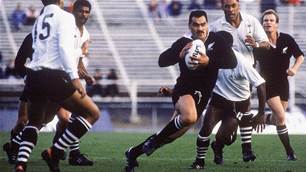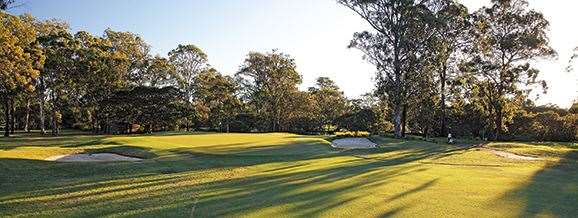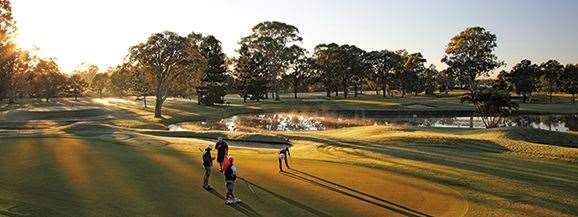This suburban Brisbane club boasts an unrivalled list of former champions that have gone on to find major tournament success, which says something for the quality of the course where they learned the game.
Trivia question: What suburban Brisbane golf club has seen two of its club and junior champions go on to win Major Championships as professionals? Unless you answered Virginia Golf Club you’re wrong.
The challenging layout was the home club of Greg Norman and Wayne Grady during the 1970s, and the pair collected four club championships between them in six years. The ‘baby’ Shark went back-to-back in 1972 and 1973 and ‘Grades’ emulated that feat in 1976 and 1977. Of course, Norman went on to become the World No.1 golfer for 331 weeks of his career, which garnered two Open Championship titles. Grady captured his own major at the 1990 PGA Championship.
In fact, one of the biggest moments in the club’s history came in 1989 when Norman and Grady played an exhibition match against two teenage Virginia members – Shane Tait and David Podlich, who would later go onto have professional careers of their own.
By the time the foursome arrived on the 1st tee, more than 12,000 people lined the entire length of the par-5 opener. The pros were able to beat the youngsters by three, raised some valuable money for junior golf and gave the then teens a lifetime experience.
The club has also produced some elite amateurs as well. Of the six Queenslanders to have won the Australian Amateur Championship, two have hailed from the Virginia club – Jack Rayner in 1955 and Andrew Buckle in 2001.
It’s a fine record for a club that had humble beginnings in Brisbane’s northern suburbs a tick over 85 years ago.
The first meeting to form a golf club at Virginia was conducted
in 1928 and not long after a site was chosen and nine holes were designed and laid out by an engineer for the Department of Main Roads. Ironically, the club’s first champion, Wyndham Wilson, was also an engineer.
The layout was extended to 18 holes within four years and grew even more during the 1950s. In 1958 a further 72.5 acres of land adjoining the course was purchased and acclaimed designer Al Howard was joined by golfing legend Norman von Nida to create a 27-hole layout which remains, with several upgrades, in play today.
In recent years, Virginia has gained a reputation as one of Brisbane’s most beautiful layouts, with its combination of sweeping fairways, meandering creeks, undulating greens and 56 bunkers scattered throughout.
I don’t think it is any coincidence that such good players have emerged from the Virginia ranks over the years. A round on the par-71 course will certainly give you an insight into how good you might have to be to get your ball around the 6,117 metres in par figures.
Most fairways are lined with mature trees, thickly in parts, and while there are some lengthy holes that require a couple of spirited blows to reach the putting surface, I found that conservative play was definitely a better option than opening the shoulders up around here.
Standing on the 1st tee I imagined what it would have been like to see 12,000 people lining the fairway all the way to the green some 490 metres away. There were no gallery ropes for that Norman-Grady exhibition so spectators literally lined the edge of the fairway. The fairway here is relatively flat and veers slightly left before turning gradually right and then left again for the last 100-plus metres of the journey to the green. Perhaps the key to getting off to a good start is putting your second shot in a good position to have a straightforward approach to the flag with your third shot, which must avoid four bunkers and a lake off to the right.
If the good start you’d hoped for doesn’t come to pass, you might feel under the pump heading to the 2nd tee. The 383-metre par-4 is a tight driving hole where length and precision are necessary to get to the green in regulation. That is the foundation of the test here and if you can stay clear of the trees left and right and get your second shot somewhere near the green and escape with a par, be thankful for it.
Many of the bunkers you’ll find around the Virginia layout have been either upgraded or have been added in recent years and the biggest of these sandy hazards lies beside the 3rd green. The 168-metre par-3 is lined by out-of-bounds to the right and climbs gradually uphill to a large rolling green, where a back right flag is one of the hardest to approach across the entire layout.
Some of the best holes at Virginia cover the terrain with the most elevation change, like the par-4 5th and 6th holes. Both these holes feature a rolling uneven fairway which comes into play from the tee and can influence the lie you have for a second shot approach.
Virginia’s most memorable offering comes on the back nine at the 444-metre 13th, which is a fine risk-and-reward par-5 where you can make a huge impression on your scorecard – good or bad. By the time you have reached tee here you will be of the realisation that the tight driving lines at Virginia must have played a role in Norman eventually becoming one of the longest and straightest drivers in the game. Being able to unleash his power with precision accuracy would have been a great asset around this layout and the 13th would have been fodder for him. But for us mere mortals, the drive here is all important to the end result. Thread your drive down the fairway and then you have a big decision to make if you are within range of reaching the putting surface in two shots. You can either go for the green, which lies beyond three bunkers and a lake skirting the left edge. The water also stretches up the fairway so you have to fly your approach most of the way to the green. What is not so visible from the fairway is another lake that will catch any short sliced wide to the right of the tree line. The lay-up is also a tricky one with two fairway bunkers lying pitching wedge distance from the green and are best avoided.
Virginia’s heritage is one worth boasting about and the future looks good too. The club’s members voted in 2012 to implement a design masterplan by Wayne Grady. His plan will see gradual tweaks of the current 1 to 18 holes, and the present 19-27 routing of holes will be upgraded, over the next two decades.
THE COURSE
LOCATION: Elliott Rd, Banyo. About 10 minutes’ drive from Brisbane Airport and 20 minutes’ north of the CBD.
CONTACT: (07) 3267 7057.
WEBSITE: www.virginiagolfclub.com.au
DESIGNER: D.A Crawford (1928, 1933), Al Howard & Norman von Nida (1963). Wayne Grady (consulting designer).
PLAYING SURFACES: Predominantly couch (fairways, tees and rough); Bermuda Tifgreen 328 (greens).
COURSE SUPERINTENDENT: Barry Lemke.
PGA PROFESSIONALS: Shayn Barnham & Brett Maxwell.
GREEN FEES: $39 (18 holes), $25 after 2pm weekdays but not on public holidays.
THE CLUB
MEMBERSHIPS: Virginia’s management has a very modern approach in delivering a premium golfing experience while maintaining the game’s fiercely guarded traditions. As a result, there are nine membership categories covering a wide range of needs and budgets.
CORPORATE GOLF: The organisation and assistance for your corporate golf day is a complimentary service of the club. Virginia’s team specialises in providing hassle free events with a difference and they will transform your golf day into a memorable experience.
EVENTS: The Blue Marker Challenge is held on the second Tuesday of each month on the championship course. The pins are tucked the tees are back, this is the toughest the course can play. Anyone who breaks their handicap wins a dozen balls, while the winner and runner up each week are invited back to the end of year Blue Marker Challenge. Entry fee for the competition also includes a burger at half way or on completion of your round.
Related Articles

International Spotlight: Omanu Golf Club

Celebrity Kiwi couple tee off in paradise


















